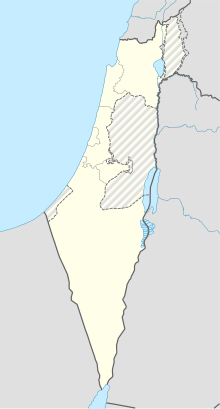Cave of the Ramban: Difference between revisions
move more specific EJ into infobox, cite unecessary |
Jiujitsuguy (talk | contribs) Located in within municipal boundaries of Jerusalem, not WB |
||
| Line 6: | Line 6: | ||
|imagealttext = |
|imagealttext = |
||
|caption = |
|caption = |
||
|map_type = |
|map_type = Israel |
||
|map_alt = |
|map_alt = |
||
|latitude = 31.789233 |
|latitude = 31.789233 |
||
Revision as of 23:24, 11 November 2010
 | |
| Location | Wadi Joz, East Jerusalem |
|---|---|
| Type | burial chamber |
| Length | 19 m |
| Width | 20 m |
| Height | 3.5 m |
| Site notes | |
| Ownership | Jerusalem Islamic Waqf |
| Public access | Limited |
The Cave of the Ramban is believed by some to be the traditional burial place of Nahmanides (also known as Ramban), a foremost rabbinical scholar during the medieval era.
The cave is located at the foot of 'Uthman Ibn 'Afan Street, Jerusalem, in the southern cliff of the Upper Kidron Valley, on a slope descending into Wadi Joz.[1] It forms a large, rock-hewn space measuring 19 by 20 m, up to 3.5 m high and is supported by two columns. The area once functioned as an ancient underground stone quarry. Above the cave's façade, in the upper portion of the cliff, are the remains of a square rock-cut chamber which may have originally belonged to a burial cave.[2]
The cave is believed by some Jews to be the site where Ramban prayed in the 13th-century and the place of his interment. It is thus claimed to have been a holy site for Jews for many centuries.[3][4]
In 2000, the cave became a subject of controversy between a group of Jewish inhabitants in Wadi Joz and the Muslim owner of the site, who had fenced off the cave in protest to Jewish settlement in the area.[3] The National Authority for Holy Sites convinced the Ministry of Religious Affairs of its religious significance and the cave was declared a holy site and handed over to the ministry’s control.[5] The Muslim wakf subsequently petitioned the High Court of Justice which resulted in a temporary injunction freezing the site's designation. In 2003, a government committee was appointed to examine the issue.[3] While acknowledging the site's connection to the Jewish faith, it was decided that the court could rule on the matter. This however was thwarted when the holy status was reinstated by a government minister.[5] The wakf persisted in its battle for control of the site in the courts and in 2008 it was decided that the cave be placed under the wakfs authority and Jews were banned from entering.[5]
Other traditions hold that Ramban was buried in Silwan, in Hebron or in Acre.[6]
See also
References
- ^ Amos Kloner; Agudah le-seḳer arkheʼologi shel Yiśraʼel (2001). Survey of Jerusalem: the northeastern sector. Rashut ha-ʻatiḳot, ha-Agudah le-seḳer arkheʼologi shel Yiśraʼel. p. 314. Retrieved 3 November 2010.
- ^ Amos Kloner; Boaz Zissu (2007). The Necropolis of Jerusalem in the Second Temple period. Peeters. p. 238. ISBN 9789042917927. Retrieved 3 November 2010.
- ^ a b c David E. Guinn (2006). Protecting Jerusalem's holy sites: a strategy for negotiating a sacred peace. Cambridge University Press. pp. 14–15. ISBN 9780521866620. Retrieved 3 November 2010.
- ^ Zev Vilnay (10 March 2003). Legends of Palestine. Kessinger Publishing. pp. 100–102. ISBN 9780766141285. Retrieved 6 November 2010.
- ^ a b c Court: Ramban’s Cave Belongs to the Muslim Waqf, theyeshivaworld.com, December 21, 2008.
- ^ Moshe Maʻoz; Sari Nusseibeh (2000). Jerusalem: points of friction, and beyond. BRILL. p. 118. ISBN 9789041188434. Retrieved 3 November 2010.
Sources
- Nadavi Shragai, Ramban Cave Made Place of Worship, Haaretz. (May 23, 2000)

